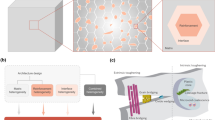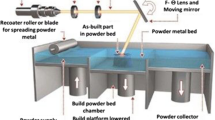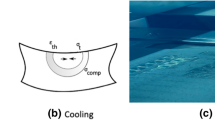Abstract
Recent advancements in additive manufacturing (AM) have opened new possibilities for fabricating highly complex lattice structures with enhanced mechanical properties, particularly hybrid and functional gradient structures. Most of the conducted research focused on linear/longitudinal designs for both hybrid and functional gradient structures. This study focuses on designing and evaluating novel functionally graded radially hybridized structures, combining different unit cells from beam-based and surface-based structures. The research introduces a cylindrical/radial hybridization approach, incorporating three distinct unit cells: body-centered cubic (BCC), face-centered cubic (FCC), and octet from beam-based structures, and diamond, gyroid, and split-p from surface-based structures. Polylactic acid (PLA) was selected as the material, and fused filament fabrication (FFF) was employed for fabrication. Quasi-static compression tests were conducted to assess the influence of hybridization and functional gradience on compressive modulus, ultimate strength, specific energy absorption, and failure properties. Both experimental and numerical results demonstrated that functionally graded lattice structures, whether surface-based or beam-based, exhibited improved mechanical performance. The surface-based functionally graded lattice structures showed the highest compressive modulus (71%), ultimate strength (36%), and specific energy absorption (19%). On the other hand, the beam-based functionally graded structures displayed a higher compressive modulus (50%), ultimate strength (11%), and specific energy absorption (19%). However, it should be noted that the beam-based functionally graded structures exhibited a decrease in these properties due to factors such as unit cell size, volume fraction, and structural buckling. Overall, the findings highlight the superior mechanical properties of functionally graded lattice structures compared to hybrid lattice structures.














Similar content being viewed by others
Data availability
Data available on request from the authors.
References
Nazir A, Abate KM, Kumar A, Jeng JY (2019) A state-of-the-art review on types, design, optimization, and additive manufacturing of cellular structures. The Int J Adv Manuf Technol 104(9):3489–3510. https://doi.org/10.1007/S00170-019-04085-3
Palaniyappan S, Veeman D, Sivakumar NK, Natrayan L (2022) Development and optimization of lattice structure on the walnut shell reinforced PLA composite for the tensile strength and dimensional error properties. Structures 45:163–178. https://doi.org/10.1016/J.ISTRUC.2022.09.023
C. Körner (2016) Additive manufacturing of metallic components by selective electron beam melting — a review. 61:361–377. https://doi.org/10.1080/09506608.2016.1176289
Aremu AO, Brennan-Craddock JPJ, Panesar A, Ashcroft IA, Hague RJM, Wildman RD, Tuck C (2017) A voxel-based method of constructing and skinning conformal and functionally graded lattice structures suitable for additive manufacturing. Addit Manuf 13:1–13. https://doi.org/10.1016/j.addma.2016.10.006
Andrews EW, Gibson LJ, Ashby MF (1999) The creep of cellular solids. Acta Mater 47:2853–2863. https://doi.org/10.1016/S1359-6454(99)00150-0
Xu F, Zhang X, Zhang H (2018) A review on functionally graded structures and materials for energy absorption. Eng Struct 171:309–325. https://doi.org/10.1016/J.ENGSTRUCT.2018.05.094
Boggarapu V, Gujjala R, Ojha S, Acharya S, Venkateswarababu P, Chowdary S, kumarGara D (2021) State of the art in functionally graded materials. Compos Struct 262:113596. https://doi.org/10.1016/J.COMPSTRUCT.2021.113596
Veloso F, Gomes-Fonseca J, Morais P, Correia-Pinto J, Pinho ACM, Vilaça JL (2022) Overview of Methods and Software for the Design of Functionally Graded Lattice Structures. Adv Eng Mater 24:2200483. https://doi.org/10.1002/ADEM.202200483
Pérez-Ruiz JD, de Lacalle LNL, Urbikain G, Pereira O, Martínez S, Bris J (2021) On the relationship between cutting forces and anisotropy features in the milling of LPBF Inconel 718 for near net shape parts. Int J Mach Tools Manuf 170. https://doi.org/10.1016/j.ijmachtools.2021.103801
Teimouri M, Mahbod M, Asgari M (2021) Topology-optimized hybrid solid-lattice structures for efficient mechanical performance. Structures 29:549–560. https://doi.org/10.1016/J.ISTRUC.2020.11.055
Hailu YM, Nazir A, Lin SC, Jeng JY (2021) The effect of functional gradient material distribution and patterning on torsional properties of lattice structures manufactured using multijet fusion technology. Materials 14. https://doi.org/10.3390/ma14216521
Xu Z, La Mendola I, Razavi SMJ, Bagherifard S (2023) Additive manufactured Triply Periodical Minimal Surface lattice structures with modulated hybrid topology. Eng Struct 289. https://doi.org/10.1016/j.engstruct.2023.116249
Calleja‐ochoa A, Gonzalez‐barrio H, de Lacalle NL, Martínez S, Albizuri J, Lamikiz A (2021) A new approach in the design of microstructured ultralight components to achieve maximum functional performance. Materials 14. https://doi.org/10.3390/ma14071588
Chen Z, Xie YM, Wu X, Wang Z, Li Q, Zhou S (2019) On hybrid cellular materials based on triply periodic minimal surfaces with extreme mechanical properties. Mater Des 183:108109. https://doi.org/10.1016/J.MATDES.2019.108109
White BC, Garland A, Alberdi R, Boyce BL (2021) Interpenetrating lattices with enhanced mechanical functionality. Addit Manuf 38:101741. https://doi.org/10.1016/J.ADDMA.2020.101741
Zhang S, Yang F, Li P, Bian Y, Zhao J, Fan H (2022) A topologically gradient body centered lattice design with enhanced stiffness and energy absorption properties. Eng Struct 263:114384. https://doi.org/10.1016/J.ENGSTRUCT.2022.114384
Yang X, Gong Y, Zhao L, Zhang J, Hu N (2023) Compressive mechanical properties of layer hybrid lattice structures fabricated by laser powder bed fusion technique. J Market Res 22:1800–1811. https://doi.org/10.1016/j.jmrt.2022.12.031
Thirunavukkarasu N, Gao J, Peng S, Laroui A, Wu L, Weng Z (2023) Mechanically robust 3D printed elastomeric lattices inspired by strong and tough hierarchical structures. Addit Manuf 66. https://doi.org/10.1016/j.addma.2023.103451
Kladovasilakis N, Tsongas K, Tzetzis D (2023) Development of novel additive manufactured hybrid architected materials and investigation of their mechanical behavior. Mech Mater 176:104525. https://doi.org/10.1016/J.MECHMAT.2022.104525
Alberdi R, Dingreville R, Robbins J, Walsh T, White BC, Jared B, Boyce BL (2020) Multi-morphology lattices lead to improved plastic energy absorption. Mater Des 194. https://doi.org/10.1016/J.MATDES.2020.108883
Lei H, Li C, Zhang X, Wang P, Zhou H, Zhao Z, Fang D (2021) Deformation behavior of heterogeneous multi-morphology lattice core hybrid structures. Addit Manuf 37:101674. https://doi.org/10.1016/J.ADDMA.2020.101674
Li S, Hu M, Xiao L, Song W (2020) Compressive properties and collapse behavior of additively-manufactured layered-hybrid lattice structures under static and dynamic loadings. Thin-Walled Struct 157:107153. https://doi.org/10.1016/J.TWS.2020.107153
Li L, Yang F, Li P, Wu W, Wang L (2022) A novel hybrid lattice design of nested cell topology with enhanced energy absorption capability. Aerosp Sci Technol 128:107776. https://doi.org/10.1016/J.AST.2022.107776
Maskery I, Hussey A, Panesar A, Aremu A, Tuck C, Ashcroft I, Hague R (2017) An investigation into reinforced and functionally graded lattice structures. J Cell Plast 53:151–165. https://doi.org/10.1177/0021955X16639035
Hu J, Wang S, Wang Y, Li F, Luo Z (2019) A lightweight methodology of 3D printed objects utilizing multi-scale porous structures. Vis Comput 35:949–959. https://doi.org/10.1007/S00371-019-01672-Z/FIGURES/9
Al Rifaie M, Mian A, Srinivasan R (2018) Compression behavior of three-dimensional printed polymer lattice structures. 233:1574–1584. https://doi.org/10.1177/1464420718770475
Zhong T, He K, Li H, Yang L (2019) Mechanical properties of lightweight 316L stainless steel lattice structures fabricated by selective laser melting. Mater Des 181:108076. https://doi.org/10.1016/J.MATDES.2019.108076
Xiao L, Song W (2018) Additively-manufactured functionally graded Ti-6Al-4V lattice structures with high strength under static and dynamic loading: Experiments. Int J Impact Eng 111:255–272. https://doi.org/10.1016/J.IJIMPENG.2017.09.018
Baykasoğlu C, Baykasoğlu A, Cetin E (2023) Multi-objective crashworthiness optimization of square aluminum tubes with functionally graded BCC lattice structure filler. Int J Crashworthiness. https://doi.org/10.1080/13588265.2023.2183801
Rodrigo C, Xu S, Durandet Y, Fraser D, Ruan D (2023) Quasi-static and dynamic compression of additively manufactured functionally graded lattices: Experiments and simulations. Eng Struct 284. https://doi.org/10.1016/j.engstruct.2023.115909
Dwyer CM, Carrillo JG, De la Peña JAD, Santiago CC, MacDonald E, Rhinehart J, Williams RM, Burhop M, Yelamanchi B, Cortes P (2023) Impact Performance of 3D Printed Spatially Varying Elastomeric Lattices. Polymers (Basel) 15. https://doi.org/10.3390/polym15051178
Novak N, Al-Ketan O, Borovinšek M, Krstulović-Opara L, Rowshan R, Vesenjak M, Ren Z (2021) Development of novel hybrid TPMS cellular lattices and their mechanical characterisation. J Market Res 15:1318–1329. https://doi.org/10.1016/J.JMRT.2021.08.092
A. Karakoç (2021) RegionTPMS — Region based triply periodic minimal surfaces (TPMS) for 3-D printed multiphase bone scaffolds with exact porosity values, SoftwareX 16. https://doi.org/10.1016/j.softx.2021.100835
BS ISO 13314:2011 - Mechanical testing of metals. Ductility testing. Compression test for porous and cellular metals (British Standard), (n.d.). https://webstore.ansi.org/standards/bsi/bsiso133142011. Accessed May 11, 2023
Yang L, Ferrucci M, Mertens R, Dewulf W, Yan C, Shi Y, Yang S (2020) An investigation into the effect of gradients on the manufacturing fidelity of triply periodic minimal surface structures with graded density fabricated by selective laser melting. J Mater Process Technol 275:116367. https://doi.org/10.1016/J.JMATPROTEC.2019.116367
Yang X, Yang Q, Shi Y, Yang L, Wu S, Yan C, Shi Y (2022) Effect of volume fraction and unit cell size on manufacturability and compressive behaviors of Ni-Ti triply periodic minimal surface lattices. Addit Manuf 54:102737. https://doi.org/10.1016/J.ADDMA.2022.102737
Dara A, Bahubalendruni MAR, JohnneyMertens A, Balamurali G (2022) Numerical and experimental investigations of novel nature inspired open lattice cellular structures for enhanced stiffness and specific energy absorption. Mater Today Commun 31:103286. https://doi.org/10.1016/J.MTCOMM.2022.103286
Li G, Xu F, Sun G, Li Q (2015) A comparative study on thin-walled structures with functionally graded thickness (FGT) and tapered tubes withstanding oblique impact loading. Int J Impact Eng 77:68–83. https://doi.org/10.1016/J.IJIMPENG.2014.11.003
Lowell S, Shields JE, Thomas MA, Thommes M (2004) Pore Size and Surface Characteristics of Porous Solids by Mercury Porosimetry: 189–212. https://doi.org/10.1007/978-1-4020-2303-3_11
ImageJ, National Institutes of Health. (n.d.). https://imagej.nih.gov/ij/index.html Accessed 18 May 2023
ImageJ User Guide - IJ 1.46r, (n.d.). https://imagej.nih.gov/ij/docs/guide/index.html Accessed 11 May 2023
Mbiakop A, Constantinescu A, Danas K (2015) A model for porous single crystals with cylindrical voids of elliptical cross-section. Int J Solids Struct 64–65:100–119. https://doi.org/10.1016/J.IJSOLSTR.2015.03.017
Yin H, Zhang W, Zhu L, Meng F, Liu J, Wen G (2023) Review on lattice structures for energy absorption properties. Compos Struct 304:116397. https://doi.org/10.1016/J.COMPSTRUCT.2022.116397
Zhou J, Dong C, Wang Z, Chen B, Qin R, Niu X (2022) Approaching ideal energy absorption through the multicellular structure with gradient material distribution. Int J Mech Sci 225:107355. https://doi.org/10.1016/J.IJMECSCI.2022.107355
Compton BG, Lewis JA, Compton BG, Lewis A (2014) 3D-Printing of Lightweight Cellular Composites. Adv Mater 26:5930–5935. https://doi.org/10.1002/ADMA.201401804
Zohdi N, Yang R (Chunhui), Torres-Giner S, Vargas M (2021) Material Anisotropy in Additively Manufactured Polymers and Polymer Composites: A Review. Polymers 13:3368. https://doi.org/10.3390/POLYM13193368
Nazir A, Gokcekaya O, MdMasumBillah K, Ertugrul O, Jiang J, Sun J, Hussain S (2023) Multi-material additive manufacturing: A systematic review of design, properties, applications, challenges, and 3D printing of materials and cellular metamaterials. Mater Des 226:111661. https://doi.org/10.1016/J.MATDES.2023.111661
Funding
The authors from Hong Kong Polytechnic University (PolyU) acknowledge the financial support under grant number: P0040173. The authors from King Fahd University of Petroleum & Minerals (KFUPM) would also like to acknowledge the support provided by the Deanship of Research Oversight and Coordination (DROC) for funding this work through project No. EC231001.
Author information
Authors and Affiliations
Corresponding author
Ethics declarations
Ethics approval
Not Applicable.
Consent to participate
Not Applicable.
Consent for publication
Not Applicable.
Conflicts of interest
The authors have no conflict of interest to declare.
Additional information
Publisher's note
Springer Nature remains neutral with regard to jurisdictional claims in published maps and institutional affiliations.
Rights and permissions
Springer Nature or its licensor (e.g. a society or other partner) holds exclusive rights to this article under a publishing agreement with the author(s) or other rightsholder(s); author self-archiving of the accepted manuscript version of this article is solely governed by the terms of such publishing agreement and applicable law.
About this article
Cite this article
Hussain, S., Nazir, A., Waqar, S. et al. Effect of additive manufactured hybrid and functionally graded novel designed cellular lattice structures on mechanical and failure properties. Int J Adv Manuf Technol 128, 4873–4891 (2023). https://doi.org/10.1007/s00170-023-12201-7
Received:
Accepted:
Published:
Issue Date:
DOI: https://doi.org/10.1007/s00170-023-12201-7




